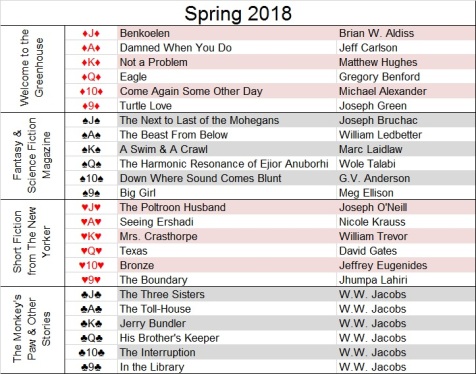“Binge-watching” has become quite common in today’s world – both the compound verb and the act itself. I myself have enjoyed a few watching binges. But this past weekend, I  spent a lot of my time binge-reading. Yes, at first one wouldn’t think there could easily be such a thing, as books take so much longer to read than episodes of your favorite tv series. Well, the solution is obvious: short stories can be binge-read. (“…and we’re just the guys to do it!”)
spent a lot of my time binge-reading. Yes, at first one wouldn’t think there could easily be such a thing, as books take so much longer to read than episodes of your favorite tv series. Well, the solution is obvious: short stories can be binge-read. (“…and we’re just the guys to do it!”)
Back in late January, I mapped out 24 short stories to read during the 24 in 48 readathon and, as often is the case, failed to complete my mission. I didn’t even blog about the stories I read then, only tweeting updates to the #24in48 hashtag. The remaining stories had been kind of rotting on my TBR vine ever since, but I didn’t want to forget them and this past weekend I resolved to just “knock out” the rest of them. The exercise felt similar, emotionally, to the more common form of tv show binge-watching. As usual when I read through a batch of stories, I discovered some real gems, and I’d like to tell you about a few of my favorites:
“Irises” by Elizabeth Genovise, found in the 2016 edition of “The O. Henry Prize Stories” anthology. Uniquely told by an unborn baby narrator (!!) it provided poignant insight into a love affair. “I am not yet a daughter but rather a subtle shift in the taste and color of her world, unfurling at the edges of her consciousness as the autumn does just before it erupts into deep reds and yellows.” Why is the narrator’s mother “ready” to have an affair? She’s an artist, specifically a ballet dancer, and he is a well-intentioned but “unfeeling” brute. “He has never known immersion in an art, never taken the artist’s gamble, and so the sheer foreignness of my mother’s commitment to dancing baffles him.” This was truly a great story with some of my favorite writing that I’ve encountered lately. I recommend you pick up a copy and read it for yourself. You can find out more about this author at https://www.elizabethgenovisefiction.org/
“A List of Forty-Nine Lies” by Steven Fischer from the Jan-Feb 2018 issue of Fantasy and Science Fiction magazine. A very effective format for a story about a “suicide-bomber-like” revolutionary of the future, in opposition to the ruling dystopian society called The New Dawn. A very short story, only forty-nine sentences long, and each one of them is a lie. If you weren’t aware of the title of the story, whether or not the sentences are lies, would not be immediately obvious, but by the end of the story, no knowledge of the title would be necessary. Bravo. The entire piece of flash fiction – at least the first draft – was written during a tedious lecture on medical statistics (the author is described as a fourth-year medical student in the story’s intro)
“Train to Harbin by Asako Serizawa, also from the 2016 edition of “The O. Henry Prize Stories” anthology. A hard-hitting story on a difficult subject – the World War II era war crimes of Japan in using Chinese prisoners for medical experiments. Told by one of the doctors/perpetrators who is, naturally, struggling with his role though he was – as the cliche goes – “only following orders.” A powerful story.
“You see, you must understand something: We had always meant to preserve lives. A few thousand enemies to save hundreds of thousands of our own? In that sense, I hardly think our logic was so remarkable or unique.”
“The Equationist” by J.D. Moyer, also from the Jan-Feb 2018 issue of Fantasy and Science Fiction magazine. Rare among short stories in that it follows almost the entire life of the protagonist who, as a precocious young math student, decides that people can be understood as equations. Some linear, some circular, some exponential. One he can’t figure out is his classmate crush, Emily Lessard – “A chaos function, maybe. I’m just learning about those.”
I also read four stories from W.W. Jacobs’ collection “The Monkey’s Paw and Other Tales,” all of which were good, but none as extraordinary as the four I list above (and none were as good as the two I’d already read during #24in48 – “The Lost Ship and “The Castaway”). Additionally, I enjoyed three more stories from the Welcome to the Greenhouse anthology (stories featuring – you guessed it – climate change)
I enjoyed my weekend binge-reading so much, I plan to make it a regular habit whenever I have a weekend largely free of other responsibilities. Maybe once or twice a season? As usual, I will randomize my reading order and have stories from four different sources; I’m assigning each to a card in a euchre deck to fit my “Deal Me In” challenge methodology. For this batch, I’m continuing on in several of the sources I started for the Readathon, while adding a new source, that being the short stories found in recent issues of The New Yorker, to which I am a digital subscriber.
What about YOU? Have you ever binge-read? Have you ever binge-watched? I’m much more interested in binge-reading, but I’d like to hear about either, frankly. 🙂

 The Card:
The Card: 